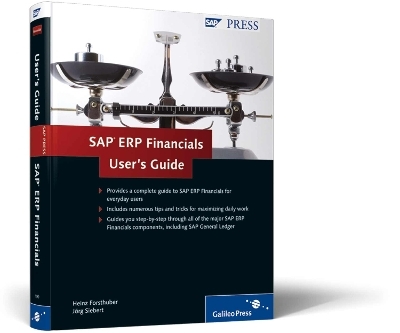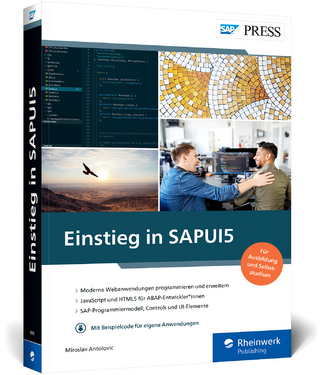
SAP ERP Financials User's Guide
SAP Press (Verlag)
978-1-59229-190-8 (ISBN)
- Titel ist leider vergriffen;
keine Neuauflage - Artikel merken
Heinz Forsthuber is an experienced SAP consultant and trainer, focusing on Controlling (CO) and Financial Accounting (FI). Currently, he works as an SAP in-house consultant in the public sector and is in charge of the FI, CO, and MM modules. Additionally, he is responsible for archiving and the user administration. Joerg Siebert began working as a consultant and trainer in the Financial Accounting area in 1996, and moved to Financials Product Sales at SAP Germany in 2003. His activities comprise both SAP R/3 and the new components in SAP ERP Financials, such as Financial Supply Chain Management, Corporate Governance, and SAP NetWeaver BI. His extensive practical experience was gained as an SAP trainer and FI/CO consultant at Cap Gemini Ernst & Young and DCW Software. His certification as a consultant for SAP FI/CO and SAP SEM, his degree in Information Management, and his qualification as CPA are the basis of Joerg's extensive technical competence.
1 Overview 19
1.1 Reports and Transaction Codes 20
1.2 Real-Time Processing and the Document Principle 21
1.3 SAP R/3 Replaces SAP R/2 22
1.4 Integration 26
1.5 SAP ERP Replaces SAP R/3 26
1.6 New Features in SAP ERP Financials (Release 6.0) 29
1.6.1 Release Upgrade 32
1.6.2 Enhancement Package 33
1.6.3 Maintenance Strategy 35
1.7 Conclusion 36
2 General Ledger Accounting 39
2.1 Basic Principles 39
2.1.1 Cost and Activity Accounting 40
2.1.2 Objectives of General Ledger Accounting 41
2.1.3 Configuring the System 41
2.1.4 Client 42
2.1.5 Chart of Accounts 42
2.1.6 Company Code 42
2.1.7 Business Area 43
2.1.8 Profit Center 43
2.1.9 Controlling Area 44
2.2 FI-GL Component 45
2.3 Master Data 47
2.3.1 Setting Up G/L Account Master Data 48
2.3.2 Maintaining G/L Accounts of Chart of Accounts Segment 49
2.3.3 Maintaining G/L Accounts of Company Code Segment 53
2.3.4 Changing G/L Account Master Data 59
2.3.5 Blocking G/L Accounts 62
2.4 Documents in the SAP System 63
2.4.1 Document Layout 63
2.4.2 Document Header 64
2.4.3 Document Type 66
2.4.4 Document Items 69
2.4.5 Posting Key 71
2.4.6 Special G/L Indicator 73
2.5 Document Entry 74
2.5.1 Entering G/L Account Postings 74
2.5.2 Entry Tools 78
2.6 New General Ledger in SAP ERP Financials 84
2.6.1 Overview 84
2.6.2 Evaluation Report for Accenture GmbH 90
2.7 Evaluations in General Ledger Accounting 98
2.7.1 Journal 98
2.7.2 Balance Sheet 101
2.8 Conclusion 103
3 Accounts Payable Accounting 105
3.1 Business Principles 105
3.2 FI-AP Software Component 106
3.3 Master Data 106
3.3.1 Structure of the Vendor Master Data 106
3.3.2 Creating a Vendor Account 108
3.3.3 Blocking a Vendor Account 116
3.4 One-Time Vendor 117
3.5 Overview of the Integrated Business Transaction 119
3.6 Entering Incoming Invoices 122
3.6.1 General Posting 122
3.6.2 Single-Screen Transaction in FI 125
3.6.3 Fast Data Entry 126
3.6.4 Invoice Verification in MM 128
3.7 Automated Payment Transactions 130
3.7.1 Payment Methods in SAP Systems 131
3.7.2 Payment Block Reasons 132
3.7.3 Accessing the Payment Program 133
3.7.4 Payment Proposal 138
3.7.5 Executing the Payment Run 144
3.8 Manual Outgoing Payments 146
3.8.1 Complete Clearing 146
3.8.2 Residual Items 149
3.8.3 Partial Payment 152
3.9 Evaluations in Accounts Payable Accounting 154
3.9.1 Confirmation of Critical Modifications 154
3.9.2 Open Item Due Date Analysis 156
3.9.3 Vendor Information System 158
3.10 Conclusion 161
4 Accounts Receivable Accounting 163
4.1 Business Principles 163
4.2 FI-AR Component 165
4.3 Master Data 166
4.3.1 Creating a Customer Account 167
4.3.2 Blocking a Customer Account 179
4.3.3 Archiving of Customer Master Records 180
4.4 Overview of the Integrated Business Transaction 182
4.5 Monitoring Credit Lines with SAP Credit Management 185
4.6 Customer Interaction with SAP Biller Direct 193
4.7 Clarifying Payment Deductions with SAP Dispute Management 200
4.8 Dunning Procedure by Telephone with SAP Collections Management 209
4.9 Dunning Procedure by Mail 217
4.9.1 Introduction to the Dunning Program 218
4.9.2 Maintaining Parameters 219
4.9.3 Creating the Dunning Proposal 224
4.9.4 Processing the Dunning Proposal 226
4.9.5 Printing Dunning Letters 232
4.10 Evaluations in Accounts Receivable 236
4.10.1 Customer List 236
4.10.2 Customer Balances 239
4.10.3 Customer Payment History 241
4.10.4 Accounts Receivable Info System 243
4.10.5 SAP Credit Management 254
4.10.6 SAP Dispute Management 255
4.10.7 SAP Collections Management 258
4.11 Conclusion 259
5 Asset Accounting 261
5.1 Business Principles 261
5.2 The SAP Software Component FI-AA 262
5.2.1 Chart of Accounts and Chart of Depreciation 263
5.2.2 Depreciation Area 264
5.2.3 Valuation Parameters 266
5.2.4 Value Transfer to General Ledger 267
5.2.5 Derived Depreciation Areas 268
5.2.6 Integration into Controlling 268
5.2.7 Integration Considerations 269
5.3 Master Data 271
5.3.1 Group Level: Asset Class 272
5.3.2 Asset-Related Level: Group Asset and Subnumber 274
5.3.3 Creating Asset Master Records 275
5.3.4 Changing an Asset Master Record 282
5.3.5 The Asset Subnumber 284
5.3.6 Blocking an Asset Master Record 285
5.4 Asset Transactions 287
5.4.1 Transaction Types for Asset Transactions 287
5.4.2 Document Types for Asset Acquisition 288
5.4.3 Posting an Asset Acquisition 288
5.4.4 FI-AA with Integrated Accounts Payable Accounting Without a Purchase Order Reference 289
5.4.5 FI-AA Without Integrated Accounts Payable Accounting and Without a Purchase Order Reference 295
5.4.6 Acquisition in MM with Integrated Accounts Payable Accounting and a Purchase Order Reference 297
5.4.7 Depreciation 301
5.4.8 Asset Retirement 305
5.4.9 Asset Transfer 310
5.5 Evaluations in Asset Accounting 314
5.5.1 Asset Balance 314
5.5.2 Directory of Unposted Assets 316
5.6 Effects of New General Ledger on FI-AA 318
5.6.1 Use of Delta Depreciation Area for Parallel Financial Reporting 318
5.6.2 Better Support for the Gross Procedure 320
5.7 Conclusion 321
6 Bank Accounting 323
6.1 Business Principles 323
6.2 The FI-BL Component 324
6.3 Master Data 324
6.4 Consequences of Introducing SEPA 328
6.5 Payment Transactions and Bank Communication 332
6.5.1 Incoming Payments 332
6.5.2 Outgoing Payments 336
6.5.3 Bank Communication 341
6.6 Processing Bank Statements 351
6.7 Cash Journal 359
6.8 Check Deposit Transaction 369
6.9 Evaluations in Bank Accounting 376
6.9.1 Liquidity Forecast 376
6.9.2 Check Register 380
6.10 Conclusion 382
7 Closing Operations 383
7.1 Basic Business Principles 383
7.2 Management of Parked Documents 386
7.3 Automatic Maintenance of the GR/IR Account 389
7.4 Transfer of Salaries and Wages 397
7.5 Provisions 401
7.6 Periodic Accruals and Deferrals 409
7.6.1 Recurring Entry Documents 410
7.6.2 Accrual Engine 415
7.7 Asset Accounting 421
7.7.1 Assets Under Construction (AuCs 422
7.7.2 Asset Inventory 430
7.7.3 Depreciation Posting Run 436
7.7.4 Asset History Sheet 450
7.8 Value Adjustments 453
7.8.1 Individual Value Adjustments 453
7.8.2 Flat-Rate Value Adjustment 457
7.9 Foreign Currency Valuation 465
7.10 Interest Calculation 474
7.11 Reconciliation Measures 479
7.11.1 Manual Checking of Postings 479
7.11.2 Technical Reconciliation of Transaction Figures 483
7.12 Intercompany Reconciliation 486
7.13 Reclassification 498
7.14 Balance Confirmations 504
7.15 Period Control 511
7.16 Tax on Sales and Purchases 515
7.17 Balance Carryforward 523
7.18 Conclusion 529
A Basic Principles of the SAP System 533
A.1 Operating SAP ERP 533
A.2 Introduction 533
A.3 Logon 534
A.3.1 Password Rules 535
A.4 Logon Procedures 536
A.5 User Interface 536
A.6 Navigation 538
A.6.1 Navigation via the Menu 538
A.6.2 Navigation via Transaction Codes 539
A.6.3 Favorites Maintenance 541
A.6.4 Navigation via the Toolbar 543
A.7 Data Entry 543
A.8 User Settings 544
A.8.1 User Interface Settings 544
A.8.2 Options 545
A.8.3 Personal Data 547
A.9 Message Types 551
A.10 Sessions 552
A.11 Storing Data 553
A.12 The SAP Library 553
A.13 The SAP Glossary 553
A.14 Logoff 554
B Glossary 555
C Menu Paths 563
C.1 Chapter 2 General Ledger Accounting 563
C.1.1 Master Data 563
C.1.2 Documents in the SAP System 563
C.1.3 Evaluations 563
C.2 Chapter 3 Accounts Payable Accounting 563
C.2.1 Master Data 563
C.2.2 Entering Incoming Invoices 564
C.2.3 Payment Transactions 564
C.2.4 Evaluations in Accounts Payable Accounting 564
C.3 Chapter 4 Accounts Receivable Accounting 565
C.3.1 Master Data 565
C.3.2 Overview of the Integrated Business Transaction 565
C.3.3 Monitoring Credit Lines 565
C.3.4 Clarifying Payment Deductions 565
C.3.5 Dunning Procedure by Telephone 565
C.3.6 Evaluations 566
C.4 Chapter 5 Asset Accounting 566
C.4.1 Master Data 566
C.4.2 Business Transactions 567
C.4.3 Evaluations 567
C.5 Chapter 6 Bank Accounting 567
C.5.1 Master Data 567
C.5.2 Payment Transactions and Bank Communication 567
C.5.3 Processing Bank Statements 568
C.5.4 Cash Journal 568
C.5.5 Check Deposit Transaction 568
C.5.6 Evaluations 568
C.6 Chapter 7 Closing Operations 568
C.6.1 Management of Parked Documents 568
C.6.2 Automatic Maintenance of the GR/IR Account 569
C.6.3 Recurring Entry Documents 569
C.6.4 Accrual Engine 569
C.6.5 Assets Under Construction 569
C.6.6 Depreciation Posting Run 570
C.6.7 Value Adjustments 570
C.6.8 Foreign Currency Valuation 571
C.6.9 Interest Calculation 571
C.6.10 Reconciliation Measures 571
C.6.11 Intercompany Reconciliation 571
C.6.12 Reclassification 572
C.6.13 Period Control 572
C.6.14 Tax on Sales/Purchases 572
C.6.15 Balance Carryforward 572
D Sample Closing Procedure Document 573
E Additional Sources of Information 577
Books 577
F The Authors 579
| Reihe/Serie | SAP PRESS Englisch |
|---|---|
| Verlagsort | Maryland |
| Sprache | englisch |
| Maße | 175 x 228 mm |
| Themenwelt | Mathematik / Informatik ► Informatik ► Netzwerke |
| Informatik ► Weitere Themen ► SAP | |
| Schlagworte | Rechnungswesen • SAP ERP Financials • SAP R/3 |
| ISBN-10 | 1-59229-190-2 / 1592291902 |
| ISBN-13 | 978-1-59229-190-8 / 9781592291908 |
| Zustand | Neuware |
| Informationen gemäß Produktsicherheitsverordnung (GPSR) | |
| Haben Sie eine Frage zum Produkt? |
aus dem Bereich


